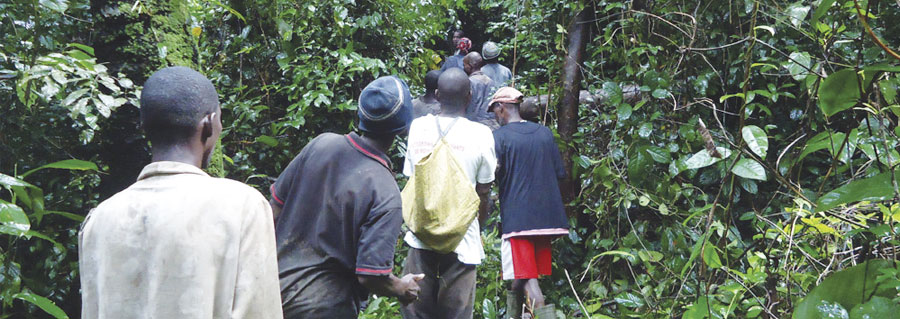Rural Communities Use GIS to Map Land and Conserve Rain Forests
The communities around Sierra Leone’s Outamba-Kilimi National Park, near the northern border with Guinea, have survived off the region’s lush rain forest for generations. But rapid deforestation—fueled by slash-and-burn agricultural practices, bush fires, hunting and poaching, logging (often illegally), and small-scale mining—is ravaging the area and other parts of the Upper Guinean rain forest, which is home to hundreds of bird species; several primate species; and many other animals, including the endangered pygmy hippopotamus. Although the forest once covered much of Sierra Leone, southeast Guinea, Liberia, southern Ivory Coast, and parts of Ghana, only an estimated 10–15 percent of it now remains.

To conserve what’s left of the rain forest, the US Forest Service’s International Program (USFS-IP) launched Sustainable and Thriving Environments for West African Regional Development (STEWARD) to present local populations with alternative livelihood options. Funded by the US Agency for International Development (USAID), the regional program—now in its third phase—teaches communities and sustenance farmers in Sierra Leone, Guinea, Ivory Coast, and Liberia how to sustainably manage forests while pursuing environmentally friendly vocations.
One of the major challenges of forest conservation in these areas, however, is figuring out who controls what. In remote areas such as the Upper Guinean rain forest, land is owned by local chiefs and tends to be leased out by word of mouth, so no official registers, or cadastres, exist to delineate who is responsible for various parcels. What’s more, the boundaries of community forests—which provide clean water, hunting grounds, and other resources to local communities—had never been mapped. Thus, communities were unaware of how much of the forest had been destroyed by logging, mining, farming, and other activities. Without that knowledge, communities could not develop strategies to use the forest’s resources sustainably.
That is why, from 2012 to 2015, Esri partner Thomson Reuters ran a GIS center in Sierra Leone’s capital of Freetown—as well as three mini GIS centers in Liberia, Guinea, and Ivory Coast—to help local communities document their land and property rights.
Insufficient Land Records
When STEWARD was launched in Sierra Leone, land records left much to be desired. During the country’s 1991–2002 civil war, a considerable number of land records were destroyed (though they weren’t all accurate in the first place). And none of the customs that dictated land and resource rights in the forest—which were based on complex relationships among the various clans, settlers, and immigrants living in the area—had ever been recorded.
Traditionally, local communities in the forests have used natural landmarks, such as big trees or prominent streams, to define the boundaries of their land. Thus, if a family had been given permission to farm the land between two mango trees but one of the mango trees got cut down decades later, the family would struggle to prove that the land was theirs.
As Sierra Leone opens up to foreign investment in logging, mining, and agribusiness, swaths of unmarked rural land have been leased and sold to companies without communities’ support and, at times, without their knowledge. In some cases, this happens because chiefs, who don’t have accurate maps, promise companies sections of land without fully knowing whether that land is theirs to sign away. So rural communities lose their land—and sometimes aren’t even compensated for it. If land disputes do arise, the government currently lacks the capacity to survey land or resolve disagreements near Outamba-Kilimi, so land-based conflicts fester.
Documenting Landholdings in the Forest
Thomson Reuters used GIS to determine target areas for documenting local land and property rights. After the target areas had been determined, USFS-IP ran education programs on land and property rights for volunteers from each community while Thomson Reuters taught them how to use its own program, Aumentum OpenTitle. OpenTitle enables users to record de facto land holdings and furnish documentary evidence of those land rights. It has ArcGIS Engine built into it, allowing users to incorporate dynamic mapping and GIS capabilities.
When the volunteers were trained, they went back to their communities to begin registering property rights. After speaking to other community members about the importance of recording land usage agreements on paper, the volunteers administered surveys to each household to get information about the size of its plots of land and which resources it could access from them. When neighbors disagreed on land boundaries, the volunteers helped mediate and recorded the resolution in OpenTitle. They then took photos of people on their land and of the landmarks that demarcated the plots. The volunteers also used handheld GPS devices to map the boundaries of each household’s land and the community forests.
This data—along with satellite images and information garnered from conversations with community elders—was aggregated at the mini GIS centers using ArcGIS. The resultant maps detailed the land and resource rights of each community and all the households within it. Once everything was compiled, each household received a set of papers that contained maps and pictures of its plots of land. Additionally, each village came to know the size of its community forest. Now residents of the Upper Guinean rain forest can resolve land disputes using written records rather than memory and land rights can now be passed down from generation to generation.
What’s more, for the first time, the government has a complete record of the local forest and which plots of land and resources belong to specific communities. Although these papers are not official government documentation of land rights, the government organizations that oversee land and forestry issues were consulted while developing the methodology used to document properties. The data was also formatted to align with other government materials so that it could be easily incorporated into official government documents.
Using the Forest Sustainably
Now that communities know the size of their land, what it contains, and the value of their natural resources, they can plan how to use the forest sustainably. With the help of STEWARD and its partners, communities are now beginning to engage in forest comanagement, which focuses on collectively managing the forest as a shared resource rather than relying on more traditional, top-down administration.
Villages near Outamba-Kilimi have formed forest management committees that include men and women of various ages who meet regularly to discuss how to use their land sustainably. Gradually, community members are instating environmentally friendly activities in their forests, from fostering honey production, cultivating medicinal plants, and cutting back on slash-and-burn agriculture to using farming techniques like crop rotation to keep the land fertile.
Local communities in the area are now starting to have serious conversations about preserving the forest for their children and their children’s children, in large part because the new maps of their land and the forest show what they have to save. Moreover, community members are finally empowered to stand up for themselves and their land in the face of pressure from companies looking to invest in the region’s natural resources.
For more information, contact Jamil Hasan, project manager for Thomson Reuters.

